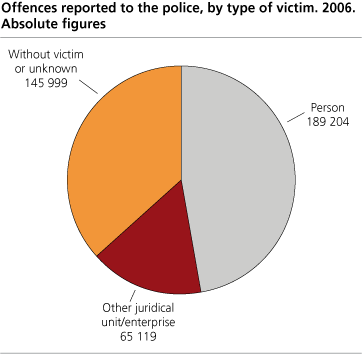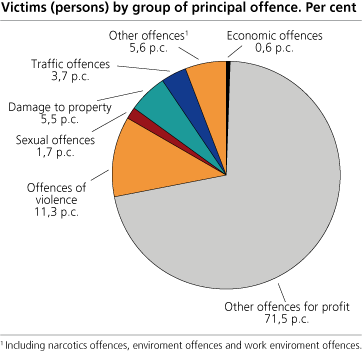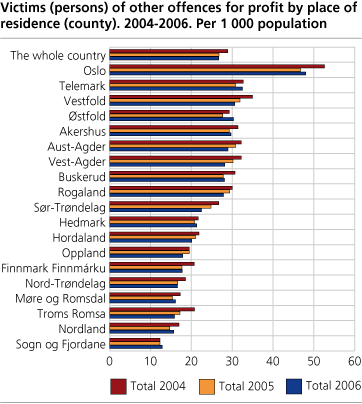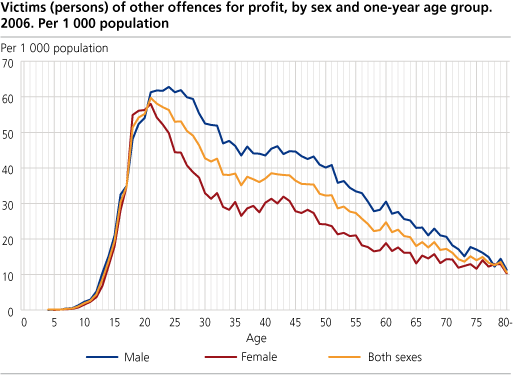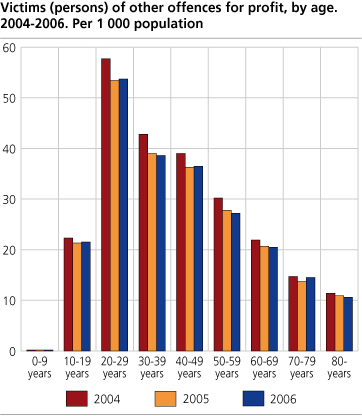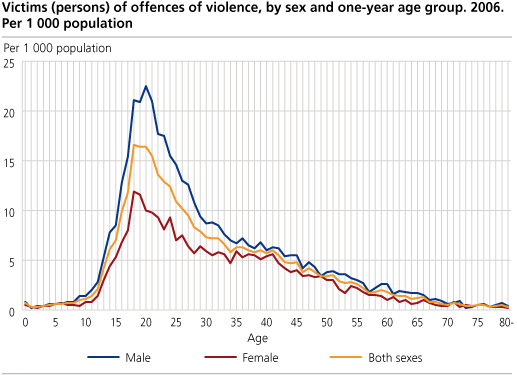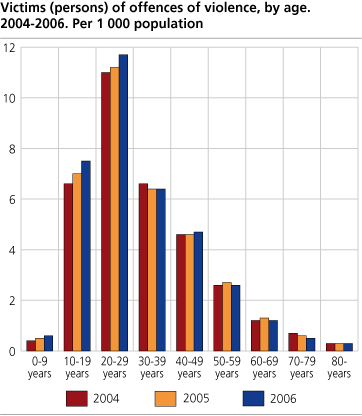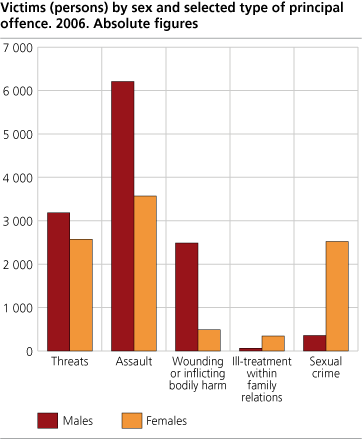Content
Published:
This is an archived release.
More men victims of violence
3.7 per cent of the Norwegian population were registered as victims of offences in 2006. Police reports show that 174 000 persons were exposed to 189 000 offences - a 2 per cent increase in persons and offences than in the previous year. Young men are over-represented among victims of both crime for profit and violence.
Of the 400 000 offences reported to the police in 2006, 47 per cent were registered with one victim (person), and 16 per cent were committed against an enterprise or other juridical units. 62 per cent of all crimes reported to the police were registered with a person as victim, contrary to only 15 per cent of all misdemeanours. Enterprises and other juridical units reported exposure to 65 000 offences, 6 per cent less than in 2005. Theft and other offences for profit represent almost 70 per cent of all offences that both enterprises and victims (persons) reported to have been exposed to.
More offences without victim - and fewer offences for profit against enterprises
The share of offences reported to the police without a victim continued to increase, and was 36 per cent in 2006. The increase is related to the increased number of narcotic and traffic crime reported (see Offences reported to the police ). These are offences which not necessarily have caused a direct experience of victimisation, and in those two groups of offences we find two thirds (97 000) of all offences without a registered victim. Crimes for profit made up 47 per cent of all offences reported to the police in 2006, 2.6 per cent less than in 2005. Statistics on victims of offences reported to the police, however, show an equal number of offences for profit against persons. The decrease compared to the year before was due to a 10 per cent reduction in the number of offences for profit reported against enterprises and other juridical units. Based on principal offence, 6 500 persons became victims of traffic offences and 9 600 of crime inflicting damage to property - an increase of 8 and 7 per cent respectively from the year before. 91 per cent of all victims (persons) were exposed to at least one crime.
Oslo residents most exposed to theft
As before, the proportion of people exposed to crime for profit is much larger in Oslo than in all the other counties. During 2006, 4.8 per cent of Oslo's population reported that they had been exposed to theft and other offences for profit, whilst the corresponding proportion in Sogn og Fjordane was 1.3 per cent. In ten counties, the proportion of victims (persons) of crime for profit was higher than in the previous year - but only two counties (Østfold and Sogn og Fjordane) had a higher proportion than in 2004. In the last three-year period, residents of eight counties have had a successive decline in the proportion of victims of crime for profit (see figure).
Types of offences vary with age
The number of people who are exposed to crime and what type of offence they are exposed to, differ with sex and, to an even greater extent, with age. Of all victims (persons) in the offences reported to the police, 59 per cent are men. Young adults have a far larger risk of being registered as victims of offences than the youngest and oldest in the population. Because victims of offences for profit make up such a large share of the total, the distribution of the victims’ age and sex for these offences dominate the registered statistics on victims in Norway (se figures).
However, looking at the distribution of groups of offences within age groups, we find relatively clear pattern and dissimilarities: As many as 70 per cent of the victims in the age group 0-9 years have sexual or violent offences as group of principal offence. The corresponding share of victims in the other age groups is systematically reduced by increasing age. For example, 27 per cent of victims in the age group 10-19 years have violent or sexual crime as principal offence, while the corresponding share is 2 per cent among victims of offences aged 80 or above. A reversed pattern is seen in terms of economical or other offences for profit, and to a certain extent also for crimes inflicting damage to property and traffic crime.
21 300 victims of 22 000 incidents of violence and threats
Compared to the previous year the number of victims (persons) of violent crimes increased by 3 per cent - mainly due to the 5 per cent increase in male victims. The number of victims (persons) with threats as principal offence, also included in the group of offence "violent crime", was however almost 5 per cent lower in 2006 than in 2005. The increase in the number of victims of violence is due to a larger increase in the number of physical violence. Finnmark residents, both men and women, are as in previous statistics on offences reported to the police, most exposed to violence and threats. The statistics also show that the proportion of victims of violent offences among people living in Telemark and Oslo are equal.
Based on reports to the police, the risk of being exposed to crimes of violence is highest during the first years after reaching the age of majority. This is the case for both men and women - but in the ages 18 to 21 years included, more than 2 per cent of all men, and about 1 per cent of all women, were registered as victims of violence or threats during 2006. For both sexes, exposure to violent offences is reduced by increasing age (see figure).
Based on principal offence, there are larger differences between men and women with regard to the exposure to wounding or inflicting bodily harm (84 per cent men) than to the less serious assaults (63 per cent men) and threats (55 per cent men). Women, on the other hand, are extremely over-represented among victims of sexual crimes (88 per cent women) and ill-treatment in family relations (85 per cent women, see figure and textbox). In 2006, 33 murders were reported to the police, with few male and above average female victims, compared to previous years. The year 2006 was unusual in this respect, considering that more than 60 percent of all victims of murder were women.
More victims of sexual crimes
During 2006, 3 000 victims of sexual crimes were registered. By principal offence, this is an increase of 12 per cent from 2005. Of all exposed to sexual crimes, one third had rape or attempted rape as principal offence and 85 per cent were below the age of 30. One fifth of the children registered as exposed to sexual intercourse were boys.
New penalty clauses and type of offenceThe Vagrancy Act was abolished on 1 January 2006, with the exception of §11 on begging, which was abolished on 1 July 2006. The Penal Code chapter 35, Misdemeanours against public order and peace, § 350 was at the same time extended to include "the one who in self-inflicted intoxication are molesting or harming others" (subsection 2). The Penal Code chapter 20, crimes concerning family relations, § 219 on ill - treatment in family relations came into force on 1 January 2006. The new provisions to a certain extent replace other similar provisions on violence and threats in the Penal Code chapter 21 and 22. In the police's criminal record register, registration of offences reported to the police from these changes could be made from 11 May 2006 included (with the possibility of registering cases committed previous to this). The new penalty clauses have caused some changes in Statistics Norway's standard for type of offence, but of less importance to the contents in the standard Group of offence. |
Statistics on victims of offences, reported to the policeThe statistics is based on information from the police criminal record system (BL/STRASAK/PAL) and embodies all with part as victim in all offences registered by the police in 2006. More on production, definitions and sources of errors in About the statistics . |
Tables:
- Table 1 Offences reported to the police, by type of victim, category of offence and group of offence. 2006. Absolute figures
- Table 2 Victims (persons) by number of offences, sex and age. 2006. Absolute figures and per cent
- Table 3 Victims (persons), by sex, age and place of residence (county). 2006. Absolute figures and per 1 000 population
- Table 4 Victims (persons), by category of offence, group of principal offence, sex and age. 2006. Absolute figures and per 1 000 population
- Table 5 Victims (persons), by category of offence, group of principal offence and one-year age group. 2006. Absolute figures
- Table 6 Victims (persons), by category of offence, group of principal offence and one-year age group. 2006. Per 1 000 population
- Table 7 Victims (persons), by category of offence, group of principal offence and place of residence (county). 2006. Number and per 1 000 population
- Table 8 Victims (persons), by sex, age and type of principal offence. 2006. Absolute figures
- Table 9 Victims (persons) of offences for profit, by sex and one-year age group. 2006. Absolute figures and per 1 000 population
- Table 10 Victims (persons) of offences for profit, by sex, age and place of residence (county). 2006. Absolute figures and per 1 000 population
- Table 11 Victims (persons) of offences for profit, by number of offences for profit, sex and age. 2006. Absolute figures and per cent
- Table 12 Victims (persons) of offences of violence, by sex and one-year age group. 2006. Absolute figures and per 1 000 population
- Table 13 Victims (persons) of offences of violence, by sex, age and place of residence (county). 2006. Absolute figures and per 1 000 population
- Table 14 Victims (persons) of offences of violence, by number of offences of violence, sex and age. 2006. Absolute figures and per cent
The statistics is now published as Offences and victims reported to the police.
Contact
-
Statistics Norway's Information Centre
E-mail: informasjon@ssb.no
tel.: (+47) 21 09 46 42

